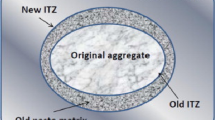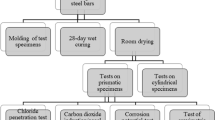Abstract
A comparative analysis of the structural behaviour of prestressed concrete sleepers made with high performance concrete (HPC) and high performance recycled aggregate concrete (HPRAC) is presented in this study. Two types of HPRAC sleepers were tested, using 50 and 100% of recycled concrete aggregate (RCA) in replacement of coarse natural aggregates. The RCA employed in this research was sourced from crushing rejected HPC sleepers. The aim of this study was to determine through analysis if the HPRAC sleepers’ behaviour fulfilled the European minimum requirements standards for prestressed concrete sleepers and compare their experimental behaviour with that of the HPC sleepers. The three types of prestressed concrete sleepers were subjected to static load tests at rail-seat and centre section (positive and negative load). In the centre section tests a comparative study between the experimental results and the proposed values of four assessment methods of ultimate capacity was carried out. Dynamic load and fatigue tests were also performed at the rail-seat section. The HPRACs and HPC sleepers met all the structural requirements for prestressed concrete sleepers. The experimental results determined the satisfactory performance of the HPRAC-50 and the HPRAC-100, which was very similar to that of the HPC sleepers. The load–strain behaviour recorded via the use of strain gauges on the prestressing bars revealed slightly higher stiffness of the HPC sleepers. The values obtained from the four assessment methods of ultimate capacity were also accurate when applied to HPRAC.










Similar content being viewed by others
References
Eurostat (2012) Waste statistics in Europe. http://epp.eurostat.ec.europa.eu/
Silva RV, De Brito J, Dhir RK (2014) Properties and composition of recycled aggregates from construction and demolition waste suitable for concrete production. Constr Build Mater 65:201–217. doi:10.1016/j.conbuildmat.2014.04.117
Agrela F, Sánchez de Juan M, Ayuso J et al (2011) Limiting properties in the characterisation of mixed recycled aggregates for use in the manufacture of concrete. Constr Build Mater 25:3950–3955. doi:10.1016/j.conbuildmat.2011.04.027
Xiao J, Li W, Fan Y, Huang X (2012) An overview of study on recycled aggregate concrete in China (1996–2011). Constr Build Mater 31:364–383. doi:10.1016/j.conbuildmat.2011.12.074
Thomas C, Setién J, Polanco JA et al (2013) Durability of recycled aggregate concrete. Constr Build Mater 40:1054–1065. doi:10.1016/j.conbuildmat.2012.11.106
Tabsh SW, Abdelfatah AS (2009) Influence of recycled concrete aggregates on strength properties of concrete. Constr Build Mater 23:1163–1167. doi:10.1016/j.conbuildmat.2008.06.007
Poon CS, Shui ZH, Lam L et al (2004) Influence of moisture states of natural and recycled aggregates on the slump and compressive strength of concrete. Cem Concr Res 34:31–36. doi:10.1016/S0008-8846(03)00186-8
Poon CS, Shui ZH, Lam L (2004) Effect of microstructure of ITZ on compressive strength of concrete prepared with recycled aggregates. Constr Build Mater 18:461–468. doi:10.1016/j.conbuildmat.2004.03.005
Kwan WH, Ramli M, Kam KJ, Sulieman MZ (2011) Influence of the amount of recycled coarse aggregate in concrete design and durability properties. Constr Build Mater 26:565–573. doi:10.1016/j.conbuildmat.2011.06.059
Kou SC, Poon CS, Etxeberria M (2011) Influence of recycled aggregates on long term mechanical properties and pore size distribution of concrete. Cem Concr Compos 33:286–291. doi:10.1016/j.cemconcomp.2010.10.003
Kou SC, Poon CS (2012) Enhancing the durability properties of concrete prepared with coarse recycled aggregate. Constr Build Mater 35:69–76. doi:10.1016/j.conbuildmat.2012.02.032
Koenders EAB, Pepe M, Martinelli E (2014) Compressive strength and hydration processes of concrete with recycled aggregates. Cem Concr Res 56:203–212
Etxeberria M, Vázquez E, Marí AR (2006) Microstructure analysis of hardened recycled aggregate concrete. Mag Concr Res 58:683–690
Etxeberria M, Vázquez E, Marí A, Barra M (2007) Influence of amount of recycled coarse aggregates and production process on properties of recycled aggregate concrete. Cem Concr Res 37:735–742. doi:10.1016/j.cemconres.2007.02.002
Etxeberria M, Gonzalez-Corominas A, Valero I Application of low-grade recycled aggregates for non-structural concrete production in Barcelona city. In: Proceedings of the third international conference on sustainable construction materials and technology
Brand AS, Roesler JR, Salas A (2015) Initial moisture and mixing effects on higher quality recycled coarse aggregate concrete. Constr Build Mater 79:83–89. doi:10.1016/j.conbuildmat.2015.01.047
Tam VWY, Gao XF, Tam CM (2005) Microstructural analysis of recycled aggregate concrete produced from two-stage mixing approach. Cem Concr Res 35:1195–1203. doi:10.1016/j.cemconres.2004.10.025
Tam VWY, Tam CM (2007) Assessment of durability of recycled aggregate concrete produced by two-stage mixing approach. J Mater Sci 42:3592–3602. doi:10.1007/s10853-006-0379-y
Kou SC, Poon CS, Chan D (2008) Influence of fly ash as a cement addition on the properties of recycled aggregate concrete. Mater Struct 41:1191–1201
Kou S, Poon C, Chan D (2004) Properties of steam cured recycled aggregate fly ash concrete. In: Vázquez E, Hendriks C, Janssen G (eds) International RILEM conference on the use of recycled materials in buildings and structures. RILEM Publications SARL, Barcelona, Spain, pp 590–599
Ajdukiewicz A, Kliszczewicz A (2002) Influence of recycled aggregates on mechanical properties of HS/HPC. Cem Concr Compos 24:269–279. doi:10.1016/S0958-9465(01)00012-9
Limbachiya MC, Leelawat T, Dhir RK (2000) Use of recycled concrete aggregate in high-strength concrete. Mater Struct 33:574–580
Kou S, Poon C (2015) Effect of the quality of parent concrete on the properties of high performance recycled aggregate concrete. Constr Build Mater 77:501–508. doi:10.1016/j.conbuildmat.2014.12.035
Tu T-Y, Chen Y-Y, Hwang C-L (2006) Properties of HPC with recycled aggregates. Cem Concr Res 36:943–950. doi:10.1016/j.cemconres.2005.11.022
Gonzalez-Corominas A, Etxeberria M (2014) Experimental analysis of properties of high performance recycled aggregate concrete. Constr Build Mater 52:227–235. doi:10.1016/j.conbuildmat.2013.11.054
Gonzalez-Corominas A, Etxeberria M (2014) Properties of high performance concrete made with recycled fine ceramic and coarse mixed aggregates. Constr Build Mater 68:618–626. doi:10.1016/j.conbuildmat.2014.07.016
ACI Committee 363 (1997) State of the art report on high-strength concrete. Farmington Hills
Ferdous W, Manalo A, Van Erp G et al (2015) Composite railway sleepers—recent developments, challenges and future prospects. Compos Struct 134:158–168. doi:10.1016/j.compstruct.2015.08.058
Manalo A, Aravinthan T, Karunasena W, Ticoalu A (2010) A review of alternative materials for replacing existing timber sleepers. Compos Struct 92:603–611. doi:10.1016/j.compstruct.2009.08.046
Union of International Railways (2012) Newsletter, high speed rail, fast track to sustainable mobility
Koh T, Shin M, Bae Y, Hwang S (2016) Structural performances of an eco-friendly prestressed concrete sleeper. Constr Build Mater 102:445–454. doi:10.1016/j.conbuildmat.2015.10.189
Rezaie F, Farnam SM (2015) Fracture mechanics analysis of pre-stressed concrete sleepers via investigating crack initiation length. Eng Fail Anal 58:267–280. doi:10.1016/j.engfailanal.2015.09.007
Rezaie F, Shiri MR, Farnam SM (2012) Experimental and numerical studies of longitudinal crack control for pre-stressed concrete sleepers. Eng Fail Anal 26:21–30. doi:10.1016/j.engfailanal.2012.07.001
Carpio J, Casado JA, Carrascal I (2004) Influencia en la resistencia a fatiga del tipo de armadura y su anclaje empleado en traviesas monobloque de hormigón pretensado. An. Mecánica la Fract. 21
Kaewunruen S, Remennikov AM (2011) Experiments into impact behaviour of railway prestressed concrete sleepers. Eng Fail Anal 18:2305–2315. doi:10.1016/j.engfailanal.2011.08.007
Kaewunruen S, Remennikov AM (2009) Progressive failure of prestressed concrete sleepers under multiple high-intensity impact loads. Eng Struct 31:2460–2473. doi:10.1016/j.engstruct.2009.06.002
Kaewunruen S, Remennikov AM (2009) Impact capacity of railway prestressed concrete sleepers. Eng Fail Anal 16:1520–1532. doi:10.1016/j.engfailanal.2008.09.026
Bezgin NÖ (2015) Climate effects on the shoulder width measurements of prestressed concrete high speed railway sleepers of ballasted tracks. Measurement 75:201–209. doi:10.1016/j.measurement.2015.07.057
Hasheminezhad A (2015) Analytical study on longitudinal crack control for B70 mono-block pre-stressed concrete sleepers. Eng Fail Anal 49:1–10. doi:10.1016/j.engfailanal.2014.12.005
Mohammadzadeh S, Vahabi E (2011) Time-dependent reliability analysis of B70 pre-stressed concrete sleeper subject to deterioration. Eng Fail Anal 18:421–432. doi:10.1016/j.engfailanal.2010.09.030
Remennikov AM, Kaewunruen S (2014) Experimental load rating of aged railway concrete sleepers. Eng Struct 76:147–162. doi:10.1016/j.engstruct.2014.06.032
Koh T-H, Bae Y-H, Hwang S-K, Sagong M (2012) Dynamic performance of eco-friendly prestressed concrete sleeper. ACI Spec Publ 289:1–18
Koh T, Han S, Sagong M (2001) Developement of eco-friendly PC sleeper using slag. In: 9th World Congress Railway Research
Koh T, Hwang S (2013) Field performance and durability of eco-friendly prestressed concrete sleeper. In: The third international conference on sustainable construction materials and technologies
Shojaei M, Behfarnia K, Mohebi R (2015) Application of alkali-activated slag concrete in railway sleepers. Mater Des 69:89–95. doi:10.1016/j.matdes.2014.12.051
European Committee for Standardization (2009) EN 13230-2 Railway applications—Track-Concrete sleepers and bearers Part 2: Prestressed monoblock sleepers. 32
ADIF (2009) Spanish Technical Specifications of Prestressed Concrete Monoblock Sleepers (ET 03.360.571.8). Madrid
Hansen TC (1992) Recycling of demolished concrete and masonry. E&FN Spon, London (UK)
Nagataki S, Gokce A, Saeki T, Hisada M (2004) Assessment of recycling process induced damage sensitivity of recycled concrete aggregates. Cem Concr Res 34:965–971. doi:10.1016/j.cemconres.2003.11.008
Padmini AK, Ramamurthy K, Mathews MS (2009) Influence of parent concrete on the properties of recycled aggregate concrete. Constr Build Mater 23:829–836. doi:10.1016/j.conbuildmat.2008.03.006
Gokce A, Nagataki S, Saeki T, Hisada M (2011) Identification of frost-susceptible recycled concrete aggregates for durability of concrete. Constr Build Mater 25:2426–2431. doi:10.1016/j.conbuildmat.2010.11.054
Fuller WB, Thompson SE (1907) The laws of proportioniong concrete. Trans ASCE 59:67–143
Neville AM (2000) Properties of concrete, Longman 981-4053-56-2. Pearson Education Asia
Eurocode 2 (2004) Design of concrete structures, European Committee for Standardization (CEN), Brussels
SIA262 (2003) Concrete structures. Swiss Society of Engineers and Architects (SIA), Zurich
Wardeh G, Ghorbel E, Gomart H (2014) Mix design and properties of recycled aggregate concretes: applicability of Eurocode 2. Int J Concr Struct Mater 9:1–20. doi:10.1007/s40069-014-0087-y
Acknowledgements
The authors wish to acknowledge the financial support of The Ministry of Economy and Competitiveness (Spain) by the INNPACT Project (IPT-2011-1655-370000) and the technical support of DRACE Infrastructuras S. L. and Instituto de Ciencias de la Construcción Eduardo Torroja.
Author information
Authors and Affiliations
Corresponding author
Ethics declarations
Conflict of interest
The authors declare that they have no conflict of interest.
Rights and permissions
About this article
Cite this article
Gonzalez-Corominas, A., Etxeberria, M. & Fernandez, I. Structural behaviour of prestressed concrete sleepers produced with high performance recycled aggregate concrete. Mater Struct 50, 94 (2017). https://doi.org/10.1617/s11527-016-0966-6
Received:
Accepted:
Published:
DOI: https://doi.org/10.1617/s11527-016-0966-6




